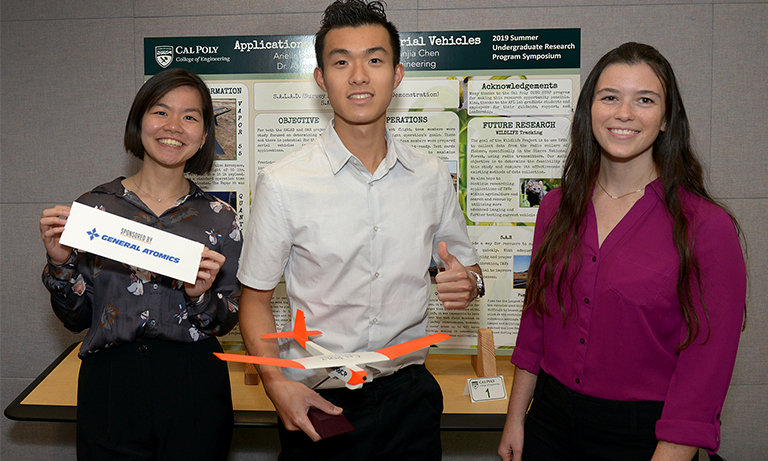On a bright, summer day north of campus, aerospace engineering student Arielle Sampson raises a pair of binoculars to her eyes, then briefly scans the sky above until she spots an object soaring like an eagle.
The drone, which her team of students launched minutes earlier, will eventually be used to help ag faculty monitor Cal Poly crops, help wildlife researchers monitor movements of cat-like carnivores in the Sierras and help search and rescue workers determine if drones are useful in finding missing persons.
“When I was building remote controlled airplanes in the past, I kind of flew them around and crashed them into trees,” Sampson said. “And that was all fun, but I really like the idea of having an application.”
Sampson’s Summer Undergraduate Research Project (SURP), Applications of Unmanned Aerial Vehicles, won first place during the annual SURP Symposium.
Sampson’s team, which also included Runjia Chen and May Kyaw, was one of roughly three dozen that displayed posters highlighting their projects during the symposium. Instead of going home and working typical summer jobs, students in the program stayed on campus and were paid to perform research in their field of interest.
Expanding SURP, now in its third year, is one of the College of Engineering’s three primary goals. (The others are to build a Center for Creative Engineering and increase diversity and inclusiveness).
“The challenge we have is that our engineering students are in such demand at the junior and senior level, that the younger students don’t have an opportunity to go out and get an internship because all of those are taken,” said Bob Crockett, associate dean for innovation infrastructure. “SURP lets them not only build a resume but also build a set of skills that they might not get in the classroom.”
Expanding the popular program, though, requires more sponsors, Crockett said. Currently, the College of Engineering funds roughly half the projects – and the demand was there for many more.
“This year we had to draw the line at 65 students whereas there were 350 students who wanted the opportunity,” Crockett said. “So sponsorships let us offer the same experience to a wider range of students.”
While the main goal is to give students experience with research, many of the projects have potential impact beyond.

Biomedical engineering major Alyssa McCulloch’s project created a model blood vessel that can be used to create medical devices. Kevin Iu, a materials engineering student, worked on a project at the Cal Poly pier that entailed testing metal for artificial reefs. And Abigail Jones, a mechanical engineering student, worked on a project that would make Cal Poly’s solar farm more efficient.
“It’s really important for me to be involved in a project that makes a difference for Cal Poly and California and to show that we as a university need to think about these things for our future,” she said.
After the 8-week program concluded, students created posters and videos summarizing their projects, then attended the SURP symposium – a showcase for the roughly 30 projects – at the Advanced Technologies Lab.
Roger Benham, who sponsored the artificial reef project, met with his team there. A Cal Poly graduate, he knows how difficult it is to get meaningful work over the summers.
“I remember being a student and not being able to get internships and working at a bike shop or a plating shop or construction jobs over the summer,” said Benham, a San Diego resident who is filling in as a lecturer in the materials engineering department this quarter.
The artificial reef business he launched could have many uses, including providing a defense against beach erosion. Iu, who is interested in environmental issues, was immediately drawn to the prospect of making a difference.
“Knowing that I can have an impact as an undergraduate student doing research was really fulfilling.”
Second place in the SURP content went to Rachel Potratz, a materials engineering student, for her project, Silicone Manifold for the Boundary Layer Data System, while computer science student Alec Williams was awarded third place for his project, Emergency Landing Guidance System.


